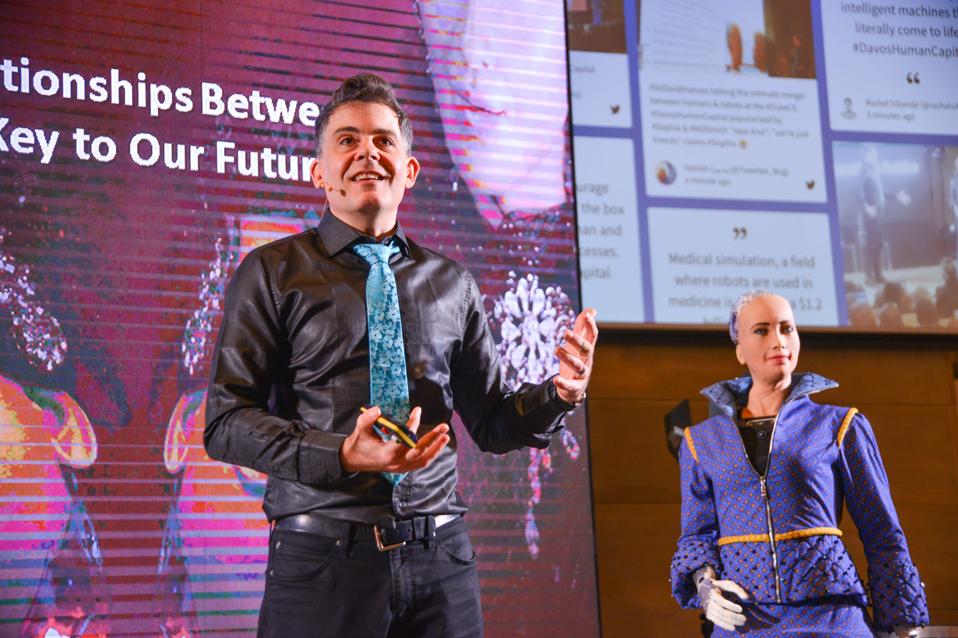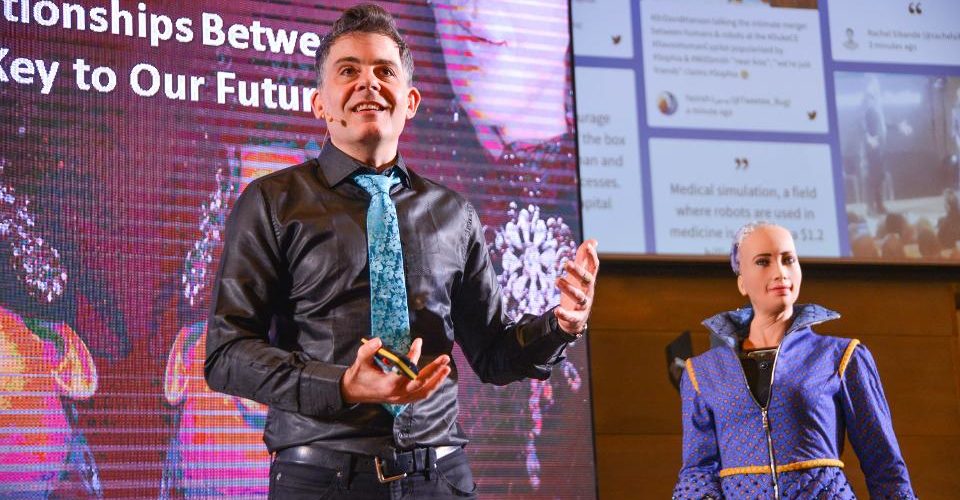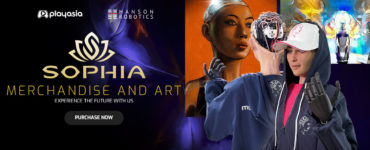Reimagining Inclusion: Incorporating Robots into your Organization
Originally posted on December 16, 2019 by Forbes, written by Michael Chavez, CEO of Duke Corporate Education

How do you view robots?
A recently published report from the Center for the Governance of AI suggests that 82% of Americans are concerned about where AI will lead next. This figure is comparable to survey results from EU respondents. As the Fourth Industrial Revolution unfolds with its promises of unfathomable computational capability, business and social observers are highlighting some very old, human fears, such as loss of jobs and status, a widening of the wealth gap and social dislocation. At the same time, there is not enough emphasis on the human opportunities presented by AI and robotics. In my recent conversations with David Hanson, Ph.D., founder of Hanson Robotics Limited, I think it’s plausible that robots can make us more human, as well as more purpose-oriented and creative. I’m also convinced that if organizations don’t prepare and understand how to leverage robots, it will lead to results that are suboptimal, potentially causing even greater backlash.
“AI and robotics are a way to enhance the quality of life for a more diverse group of people,” said Hanson, who offers a unique perspective as one of the creators of Sophia the Robot, the world’s most humanoid robot. “We want to inspire people to create a human bridge to our AI so that we can all evolve.”
As an example, consider how animated robotic imitation simulators enable healthcare professionals to keep their skills sharp. The realistic experiences they encounter in their training – using simulated human patients that are artificial, human or a combination of the two – shows doctors and other medical experts how to respond in life and death situations.
“Interacting with rich character experiences opens us to a whole new world of commercial opportunity and can bring out the best in humanity. Humans and AI working together in collaboration can enable us to reach the next level of human intelligence,” Hanson said.
How might this work? As robots take over rote, “algorithmic” tasks, humans must specialize more and more on those capabilities that are “robot-proof”, such as creativity, purpose, imagination and curiosity-based problem exploration. However, as we focus on these uniquely human capabilities and traits, we will do so through ever-increasing levels of interaction with robots and AI.
However, another uniquely human trait is bias. Robots are not immune. Some of this is understandable. Speaking from experience, interacting first-hand with a robot like Sophia can be a bit jarring. Thrilling, but jarring nonetheless. She looks and acts just like a human being as she smiles and laughs at her jokes and answers different questions with sarcasm and humor. Most of us don’t feel so unsettled interacting with Siri or Alexa because they are in boxes. Yet a humanoid robot infringes upon our identities because of their human-like look and actions. However, this is the point according to Hanson: we as humans must learn to interact with humanoid characters as an entirely new form of inclusion.
There are three types of “fit” that humans rely on to help them deal with social interactions:
1. Social fit – the tendency to like and include people who look and act the same as we do.
2. Cognitive fit – the tendency to like and include people who think the same way as we do.
3. Cultural fit – the tendency to like and include people who share the same cultural values as we do.
Robots challenge our built-in biases associated with social and cognitive fit. Through inventions like Sophia the Robot, Hanson is surfacing prejudices and thus is helping to spark a conversation on how to manage the cultural fit that organizations can create to counteract the negative effects of social and cognitive fit. This is critical in any organization when increasingly robots will be a part of it.
Also, the more robots begin to resemble humans, the more we have to consider them in our inclusive thinking. Unlike exclusionary practices towards different marginalized people groups, we are not harming the robot by excluding them (at least, not yet). However, Hanson asserts that we are harming ourselves by not being inclusive of robots because it will limit our human capabilities.
The good news is that we can counteract such biases with better tools, practices and policies. We have diversity and inclusion policies to counter our natural biases and practices towards excluded groups. We have tools to help us navigate emotions that might otherwise undermine difficult conversations with other people. We have leadership practices that force us to think about building team collaboration. In my view, Hanson is shining a spotlight on the next wave of the human-centered organization by forcing us to think about how we might incorporate robots.
As a starting point, to overcome biases towards robots and other forms of AI, consider the following:
1. Understand what diversity and inclusion mean in your organization with a human lens. Be aware of how diversity and inclusion work together. Diversity without inclusion allows you to have various groups on the payroll, but they will be disappointed if they don’t have a sense of belonging. Inclusion without diversity doesn’t fully work either because the potential of a diverse talent pool isn’t available to include.
2. Learn how AI is already working in your business. Lean into understanding where it is applicable, how it might develop and what the human cybernetic interaction looks like today.
3. Dream a little! One of Hanson’s greatest contributions with Sophia has been to help us build our human imagination skills. Try to imagine the opportunities for your business and industry. What might it look like with robots next to us?
Hanson chose the name “Sophia” because it means wisdom, a word that speaks to the heart of humanity. “If we revert to old beliefs, we run the risk of incomplete understanding,” he said.
I encourage you to consider this wisdom from Hanson as you think about including robots in your organization and the way you work.
Michael Chavez is the Chief Executive Officer of Duke Corporate Education and teaches on the Building Strategic Agility course. He is a co-author of the book Rehumanizing Leadership.






Recent Comments